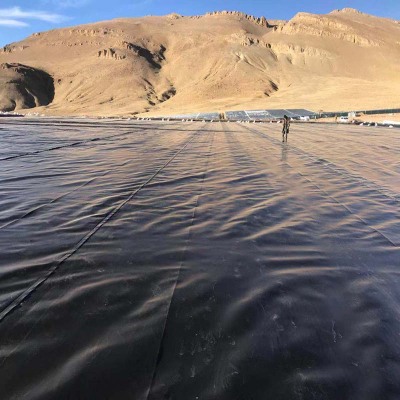
What are HDPE Geomembranes and how are they manufactured?
2025-06-13 16:18
One method is extrusion and another is calendering operations. Most of the time, the production of geomembrane sheet materials takes place through the process of extrusion. Here is how:
Step 1: Amalgamation of pelletized polymer raisin with masterbatch (pelletized concentrate)
Step 2: Pouring the mixture into an extruder for further heating to ensure proper mixing
Step 3: Ensuring that the melt creates a homogenous mixture
Step 4: Deciding the polymer orientation
Here are a few more types of geomembranes you need to know:
PVC Liner
Known for its excellent malleability, PVC Liner is one of the most reliable materials for containment of water, chemicals, and industrial waste. This impermeable liner is widely popular in areas like landfills, coal ash ponds, and stormwater management systems.
Geosynthetic Clay Liner
Geosynthetic clay liners, aka GCLs, are factory-developed hydraulic barriers that consist of layers of low-permeability materials, such as bentonite. Furthermore, geotextiles or geomembranes support these materials mechanically through needling, stitching, or chemical adhesives. They play an important role in creating a barrier system in municipal solid waste landfill applications.
EPDM (Rubber Liner)
Acronymous to ethylene propylene diene monomer, EPDM is one of the leading products for lining garden ponds, lakes, etc. These rubber liners are extremely lightweight, flexible and an affordable alternative for retaining water in various man-made streams.
Thermoplastic Sheet Liner
Thermoplastic sheet liners are biodegradable materials that are perfect for various applications like restoration, home decoration, etc. All thanks to their exceptional molding capacity. Moreover, they come with several properties, such as smoothness, strength, malleability, etc. Consequently, all these properties make them a perfect fit for various construction projects.
4 Benefits Of Geomembrane Sheets For Containment Solutions
Now that you know a few things about Geomembrane materials and their manufacturing process, let’s understand their benefits.
1-Prevents Contamination From Groundwater
The use of geomembrane liners is essentially popular for sealing canals, dams, and reservoirs to avoid contamination from groundwater. And the credit goes to their anti-leakage mechanism that perfectly plays the role.
2-Helps In Sewage Treatment
Since geomembrane liners form an impenetrable barrier, it restrains pollutants or hazardous compounds from leaking into the environment. Often used with soil liners or permeable geotextiles, they form a composite lining system that comes with extra protection.
3-Avoids Contamination of Potable Water
Imagine a scenario if you had to drink water mixed with filth and dirt. Was survival possible? Of course, not. But don’t worry, geomembranes are there to eliminate the contamination of potable water from various pollutants and soil.
What more? Geomembranes also avert the loss of water due to water infiltration into the surrounding soil.
4-Lasts Longer
The manufacturing process of geomembranes involves the use of highly durable materials which offer over hundreds-year life expectancy. Furthermore, they are resistant to chemicals and wear, allowing excellent protection against corrosion.
How To Install HDPE Geomembranes Sheets?
When it comes to installing a geomembrane liner, it’s quite a technical process. All you need is a skilled welder to get the work done. Here is the basic method for installing a geomembrane sheet:
First of all, the welder meets all the surface conditions before laying the linings.
Next, they deploy and identify the geomembrane rolls efficiently.
Once done, they ensure that the placement of the anchor system is correct.
To sum it up,
Installation of geomembrane sheets is an important aspect of the construction industry that’s essential for preventing contamination. And after reading this blog, you already know why.








